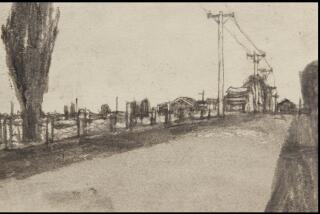Looking Back Through Eyes of Cartoonists : Hobbies: Stockbroker has collected 2,000 original editorial drawings. He feels they offer valuable lessons on American history.
- Share via
History buff Dennis Ryan doesn’t dabble in stamps, coins or bottles to chronicle America’s past. His collection marches to different ‘toons.
Ryan, 56, a Los Angeles-based senior vice president of investments for Paine Webber, has spent more than 10 years gathering 2,000 original editorial cartoons, dating back to the late 1800s, that capture historical moments in the United States. The compilation is considered by editorial cartoonists and historians to be one of the most complete and extraordinary private collections in existence.
Although Ryan, a soft-spoken stockbroker with the air of a college professor, began his hobby for fun, he now hopes to draw high school students to the collection, feeling that the cartoons would serve as a valuable tool to teach them about American history.
“These cartoons are very expressive and lively,” said Ryan. “They might hold kids’ attention span better than a textbook. The cartoons give a real immediate feeling of what was going on during those times, and how people felt about issues.”
A package of about 300 selected cartoons that have been lithographed is already being used by teachers in Burbank, Compton high schools and Beverly Hills high schools. Ryan hopes to interest school systems around the country in the cartoons.
“After all, one picture is worth a thousand words,” he said, smiling.
The collection dates to 1875 with a cartoon from the New York Daily Graphic detailing a controversy over currency--greenbacks versus silver. The most recent--a 1989 drawing by syndicated cartoonist Gary Markstein--shows a Zeus-like Ronald Reagan handing a smaller President Bush a can of Teflon and saying, “Use it well.”
Ryan said he has spent about $500,000 putting the collection together, and estimated its worth “in the low seven figures.”
He said he has original cartoons by Pulitzer Prize-winning cartoonists and from more obscure artists. The collection includes caricatures of past Presidents Theodore Roosevelt, Herbert Hoover, Harry S. Truman, Lyndon B. Johnson and others.
Among Ryan’s most prized drawings is an 1880 Harpers Weekly drawing by famed cartoonist Thomas Nast showing a depressed American Indian standing with a noose around his neck near the U.S. Capitol. The Indian is holding a ticket that reads “A vote.” The caption: “Give the Red Man a Chance.”
A 1948 New York Star drawing by Walt Kelly depicts a befuddled farmer being hauled in front of a congressional committee investigating communist infiltration. A shadowy figure behind the farmer says “Next, a man seen constantly in the company of Rhode Island Reds.”
Another in the collection is a 1968 Boston Globe cartoon by Pulitzer Prize winner Paul Szep depicting Lyndon Johnson as Pinocchio with a “four-year-long nose.”
Ryan and other history fans say there are not many collectors of editorial cartoons. “I was pleased to do something that not many people had done,” he said.
Brian Basset, president of the 200-member Assn. of American Editorial Cartoonists, praised Ryan’s collection, adding that cartoons offered a unique perspective on events.
“What better way to get an idea of what people were going through, and what they were thinking, than through an editorial cartoon,” said Basset, an editorial cartoonist for the Seattle Times.
A history teacher at Burroughs High School in Burbank, Ted Bunch, said the cartoons had helped stimulate some 11th-grade students into studying the past.
“The drawings really seemed to help them focus,” he said. “I hope to use them even more this coming semester, when we’ll be studying World War II.”
Ryan began his hobby in 1981 when he was impressed by a cartoon in the now-defunct Los Angeles Herald Examiner about the assassination attempt on Pope John Paul II. The cartoon by Bill Schorr showed a wounded Pope in the arms of a statue of the Virgin Mary, with the inscription, “Forgive Them Lord, for They Still Know Not What They Do.”
Ryan contacted Schorr and asked to buy the original drawing, which he purchased for $100. A hobby was born.
He started doing research in libraries on newspaper cartoons. He contacted artists and their heirs around the country in his quest to get original drawings.
“A lot of these cartoons were just locked up in attics or in trunks, never to be seen again,” he said. “The heirs seemed pleased that I was interested in keeping the name of the artist alive. I really feel these cartoons will do wonders for our youth in their understanding of their past.”



